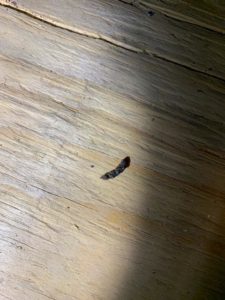Bat droppings in the attic are a sure sign that bats are or were in your home. This may seem obvious, but is the house infested? Probably not and even if it were bats are relatively easy to get rid of if you know how to do it.
Over the years many people have been trained to be afraid of bats. The first thing that comes to mind is either vampires or disease. While bats due carry rabies it’s less than 1% of bats and I’m relatively sure vampires are fiction. I’m not saying that you shouldn’t be concerned about rabies as it can be deadly. What I am saying is know the risks and be calm. If a bat is flying in the home it can be caught and tested for the disease. Once you know the results appropriate action can be taken.

Bats droppings
The bat dropping to the left is a singular dropping, but they may be found in piles as well. Typically speaking the droppings will be directly below where the bats are roosting. They may also be spread lightly throughout the attic. The amount of droppings you see can be indicative of how many bats you have, but there is not rule of thumb to judge this precisely.
In order to differentiate a bat dropping from a mouse dropping or any other animal feces there is a test. All bat droppings will pulverize into tiny pieces when stepped on. Within the droppings you’ll find shiny specks. These specks are the wing fragments of the flying insects bats have in their diet. Eating these flying insects is why bats are so good for the environment.
Seasonal signs you may have bat’s
The signs of bats and bat droppings in the attic differ from house to house but many people seem to report the same thing depending on the season we find ourselves in. During the winter people will report a faint squeaking or scratching coming from the attic or walls, others will hear what sounds like flapping wings. Our spring and summer complaints focus on bat droppings or live bats circling the house outside at dusk. Last, but certainly not least would be bats in the house during the first few weeks of August. These are typically young bats, but can be adults as well.
The beneficial, but scary pest
Bats are beneficial to the environment because they eat flying insects like mosquitoes, but knowing what to look for can help you put into perspective whether your home has a problem. Contacting a qualified nuisance wildlife operator for an inspection is your best course of action. An experienced professional can guide you through the steps of ridding the home of bats for good.
If you have bats in Ct call Envirocare Pest Control at 1-888-879-6481. We can help
